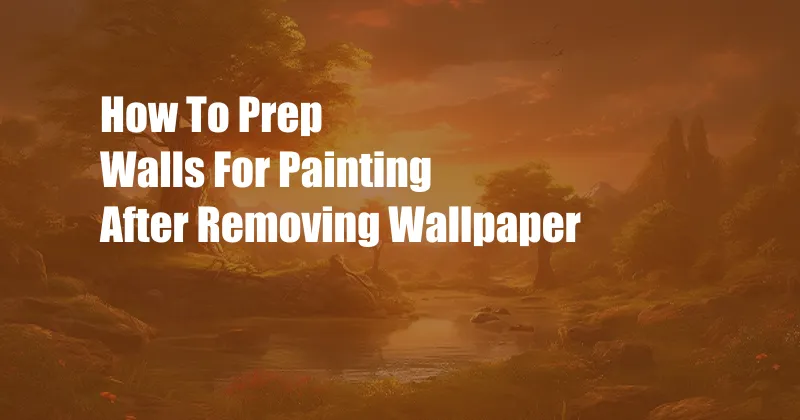
How to Prep Walls for Painting After Removing Wallpaper
When you finally decide to tackle that wallpaper removal project and give your walls a fresh, updated look, it’s important to prepare the walls properly before you start painting. Otherwise, you run the risk of the paint peeling, chipping, or bubbling, which will just lead to more headaches down the road.
In this article, we’ll walk you through everything you need to know about prepping walls for painting after removing wallpaper, from removing any remaining adhesive to patching up any holes or cracks. We’ll also provide some tips and expert advice to help you get the best possible results.
Removing Wallpaper Adhesive
The first step is to remove any remaining wallpaper adhesive from the walls. This can be done using a variety of methods, including:
- Using a wallpaper steamer: This is the most effective way to remove wallpaper adhesive, but it can be time-consuming and expensive.
- Using a wallpaper scoring tool: This is a less effective method than using a steamer, but it’s also less expensive and time-consuming.
- Using a chemical wallpaper remover: This is a harsh chemical that can damage walls if it’s not used properly.
Once you’ve removed the wallpaper adhesive, you’ll need to clean the walls with a sponge and warm water. This will remove any remaining residue and help to prepare the walls for painting.
Patching Holes and Cracks
Once the walls are clean, you’ll need to patch any holes or cracks. This can be done using a variety of materials, including:
- Spackling: This is a pre-mixed paste that can be used to fill small holes and cracks.
- Joint compound: This is a powder that must be mixed with water before it can be used. It’s a more durable option than spackling, but it’s also more difficult to apply.
- Drywall tape: This is a self-adhesive tape that can be used to reinforce joints and cracks.
Once you’ve patched the holes and cracks, you’ll need to sand them smooth. This will help to create a uniform surface for painting.
Priming the Walls
Once the walls are patched and sanded, you’ll need to prime them. Primer is a paint that helps to seal the surface of the walls and prevents the paint from peeling or chipping. It also helps to improve the adhesion of the paint.
There are a variety of different primers available, so be sure to choose one that is specifically designed for use on walls that have been wallpapered.
Painting the Walls
Now that the walls are primed, you can finally start painting! Be sure to use a paint that is specifically designed for use on walls. You’ll also want to use a high-quality brush or roller to get the best possible results.
Tips and Expert Advice
Here are a few tips and expert advice to help you get the best possible results when painting walls that have been wallpapered:
- Use a good quality primer. Primer is an important step in the painting process, so don’t skimp on the quality. A good primer will help to seal the surface of the walls and prevent the paint from peeling or chipping.
- Use a high-quality paint. The paint you use will make a big difference in the final results. Be sure to choose a paint that is specifically designed for use on walls.
- Use a good brush or roller. The brush or roller you use will also affect the final results. Be sure to use a high-quality brush or roller to get the best possible results.
- Take your time. Don’t rush the painting process. Take your time and do it right. The results will be worth it.
Frequently Asked Questions
Q: What is the best way to remove wallpaper adhesive?
A: The best way to remove wallpaper adhesive is to use a wallpaper steamer. However, if you don’t have a wallpaper steamer, you can also use a wallpaper scoring tool or a chemical wallpaper remover.
Q: What is the best way to patch holes and cracks in walls?
A: The best way to patch holes and cracks in walls is to use spackling, joint compound, or drywall tape.
Q: Do I need to prime the walls before painting?
A: Yes, it is important to prime the walls before painting. Primer helps to seal the surface of the walls and prevents the paint from peeling or chipping.
Q: What is the best way to paint walls?
A: The best way to paint walls is to use a high-quality paint and a good brush or roller. Take your time and do it right. The results will be worth it.
Conclusion
Painting walls after removing wallpaper can be a challenging task, but it’s definitely possible to get great results if you take the time to prepare the walls properly. By following the steps outlined in this article, you can ensure that your paint job will last for years to come.
Are you interested in learning more about painting walls after removing wallpaper? If so, please leave a comment below and I’ll be happy to provide you with additional information.